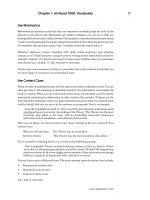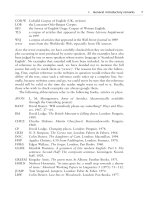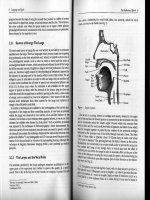economic english 3 docx
Bạn đang xem bản rút gọn của tài liệu. Xem và tải ngay bản đầy đủ của tài liệu tại đây (92.58 KB, 6 trang )
population the size, makeup, and distribution of
people in a given area
primary election a preliminary contest in which
voters give their preference for a political party’s can-
didate for public office
prime meridian an imaginary line that runs north
and south through Greenwich, England at 0° longitude
Progressivism a reform movement of the early
twentieth century that sought to remedy the problems
industrialization created
proportional representation an electoral process
in which political parties are awarded a proportion of
legislative seats based on the percentage of votes they
received
Puritans a group of English emigrants who sought to
purify the Church of England. The group started set-
tlements in New England in the seventeenth century.
ratify to confirm or give formal approval to some-
thing, such as an agreement between nations
Reconstruction (1865–1877) the period of read-
justment and rebuilding of the South that followed
the American Civil War
recession a period of low economic productivity
and income
region a land area that shares cultural, political, or
geographic attributes that distinguish it from other
areas
Renaissance a term meaning “rebirth” that refers
to a series of cultural and literary developments in
Europe in the fourteenth, fifteenth, and sixteenth
centuries
republic a government based on the concept that
power resides with the people, who then elect officials
to represent them in government
reserve ratio a portion of deposits that banks,
which are members of the Federal Reserve system, set
aside and do not use to make loans
revolution a violent change in the political order and
social structure of a society
Romanov dynasty the family that ruled Russia
from 1613 until the Russian Revolution in 1917
rule of law the principle that all citizens, including
functionaries of the government, must follow the law
sectionalism the attitude or actions of a region or
section of a nation when it supports its own interests
over that of the nation as a whole
separation of powers the practice of dividing the
authority of a government between different branches
to avoid an abuse of power
shortage when demand for a good or service is
greater than that which is produced
social studies the study of how people live every
day, including the exploration of humans’ physical
environment, culture, political institutions, and eco-
nomic conditions
socialism an economic system in which the state
owns and controls the basic factors of production and
distribution of wealth
Stamp Act a measure passed by the British Parlia-
ment in 1765 as a means of collecting taxes in the
American colonies. It required that all printed mate-
rials, including legal documents and newspapers,
carry a tax stamp.
stock exchange an organized market for buying
and selling stocks and bonds
stock market crash of 1929 a collapse in the
value of stocks that marked the onset of the Great
Depression in the United States
suffrage the right to vote
supply the amount of goods and services available for
purchase
surplus when the supply of a good or service is
greater than that which customers are willing to buy
(demand)
tariff a tax on imported, and sometimes exported,
goods
temperate zone a climatic zone characterized by
four seasons, usually a hot summer, cold winter, and
moderate spring and fall
topography the representation of features of land
surfaces, including the shape and elevation of terrain
totalitarianism a government in which the rulers of
the state control all aspects of society, including eco-
nomic, political, cultural, intellectual, and spiritual life
Townshend Acts measures passed by British Par-
liament in 1767 that taxed American colonists for
imported glass, lead, paint, paper, and tea
treaty a formal agreement between sovereign nations
or groups of nations
Treaty of Versailles of 1919 the major treaty of
five peace treaties that ended World War I
tropical zone a climatic zone characterized by a hot,
wet climate with little seasonal change
– GED SOCIAL STUDIES PRACTICE QUESTIONS–
200
Tropic of Cancer an imaginary line at 23.5 north
latitude
Tropic of Capricorn an imaginary line at 23.5
south latitude
unemployment when willing and able wage earners
cannot find jobs. The unemployment rate serves as
one index of a nation’s economic activity.
urbanization the movement of a population from
rural areas to cities with the result of urban growth
veto the power of the executive to block the laws
passed by the legislative branch
– GED SOCIAL STUDIES PRACTICE QUESTIONS–
201
PART
IV
The GED
Science Exam
I
N THIS SECTION
, you will learn all about the GED Science Test. The first chapter
explains how the exam is structured—what the questions are like and what topics
they cover. Knowing what to expect will make you more confident and comfortable
on the day of the exam; there will be no surprises. Chapters 21 through 28 review the basic
information you need to know about science and scientific inquiry for the GED exam.
Chapter 29 offers specific tips for the test, and Chapter 30 provides 75 practice questions
like those you will find on the GED.
Before you begin Chapter 20, take the pretest that follows. The questions are similar to
the questions you will find on the GED. When you are finished, check the answer key care-
fully to evaluate your results. Your performance on the pretest will help you determine how
much preparation you need and what subjects you will need to review and practice most.
Pretest: GED Science
Directions: Read the following multiple-choice ques-
tions carefully and determine the best answer. To practice
the timing of the GED exam, you should take approxi-
mately 15 minutes to answer these questions. Record
your answers on the answer sheet provided below.
Note: On the GED, you are not permitted to write in
the test booklet. Make any notes or calculations on a sep-
arate piece of paper.
1. Which of the following is unlikely to influence
climate?
a. latitude (distance from the equator)
b. longitude (time zone)
c. altitude (elevation from sea level)
d. ocean currents
e. presence of nearby mountain ranges
2. Metabolic rate per gram of body weight is higher
in smaller animals. Which animal would you
expect to burn the least amount of metabolic
fuel per gram of its body weight?
a. harvest mouse
b. dog
c. rabbit
d. elephant
e. shrew
Questions 3 and 4 are based on the following data table,
which represents the population of both wolves and deer
during the years 1955–1980 in a given area.
1955 1960 1965 1970 1975 1980
Wolves 52 68 75 60 45 49
Deer 325 270 220 210 120 80
3. Which of the following statements is true about
the years 1955–1980?
a. The population of the wolves increased over
time.
b. The population of the deer decreased at a
constant rate over time.
c. The population of the wolves increased ini-
tially but decreased after 1965.
d. The population of the deer increased over
time.
e. The population of deer in 1975 in the area
was 45.
4. Which of the following statements is true of the
wolf population from 1955–1980?
a. The wolf population increased at a constant
rate until 1975.
b. The wolf population decreased at a constant
rate after 1970.
c. The increase in the wolf population was a
result of the decrease in the deer population.
d. The wolf population increased from 1955 to
1965, decreased from 1965 to 1975, and
increased again in 1980.
e. The wolf population was at a maximum in
1960.
– THE GED SCIENCE EXAM–
204
1. abcde
2. abcde
3. abcde
4. abcde
5. abcde
6. abcde
7. abcde
8. abcde
9. abcde
10. abcde
ANSWER SHEET
5. Isomers are molecules that have the same num-
ber of the same elements, but in a different
arrangement. Which one of the following is
an isomer of 2-propanol (shown below),
which contains Carbon (C), Hydrogen (H) and
Oxygen (O)?
a.
b.
c.
d.
e.
Questions 6 and 7 are based on the following passage.
The rectilinear propagation of light and the law
of reflection had been observed long before the
development of modern theories that correctly
explain these observations. Rectilinear propaga-
tion of light refers to the fact that light travels in
straight lines. Hero of Alexandria, who lived
around the first century, explained these obser-
vations by stating that light travels along the
shortest allowed path. It wasn’t until 1657 that
Pierre de Fermat rejected Hero’s shortest-path
theory and showed that light propagates along
the path taking the least time. From his princi-
ple of least time, Fermat re-derived the law of
reflection, as well as the law of refraction. This
principle played an important role in the devel-
opment of quantum mechanics.
6. The passage shows that
a. reflection and refraction can’t be explained by
the same theory.
b. the term reflection means that light travels in
straight lines.
c. Hero of Alexandria had insight into quantum
mechanics.
d. scientists develop theories to explain the phe-
nomena they observe in nature.
e. light travels along the shortest allowed path.
7. Which general statement about science is NOT
supported by the passage?
a. A scientific finding sometimes plays a role in
other scientific findings.
b. Centuries can pass before an observation is
correctly explained by science.
c. Theory should not be based on experimental
evidence.
d. Different scientists do not always come up
with the same explanation for an observation.
e. A scientific theory should be in agreement
with observations.
8. Lung cancer accounts for over 30% of all can-
cers. Smokers are 90% of lung cancer victims.
Lung cancer is rare in societies that don’t smoke.
Which is NOT a likely consequence of these
statistics?
a. Most smokers don’t quit because they experi-
ence withdrawal symptoms.
b. Congress passed a bill requiring tobacco com-
panies to label their product as harmful.
c. The percentage of smokers dropped after
these figures were made public.
d. The U.S. military developed a program to
eliminate all tobacco use from the armed
forces.
e. The Surgeon General issued a report stating
that smoking is a health hazard.
HHH
HHH
CHHC
C
HOH
HH
CHH
C
HH
HH
CHOH
C
HHH
HHH
CHOHC
C
HOHH
HHH
CHCC
C
H
H
H
HOHH
HHH
CHHC
C
– THE GED SCIENCE EXAM–
205









